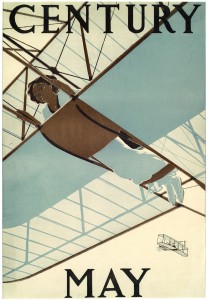
Robert J. Wildhack (1881-1940)|Poster for Century Magazine May, 1908|Collection of the Delaware Art Museum, 1985-12
This surprising poster by Robert Wildhack incorporates the image of an avant-garde flying machine at the moment those machines are transforming from experimental vehicles into a twentieth-century reality. The struts and wings of the biplane glider provide the support for an adventurous young woman laying crosswise on the glider’s lower wings. A biplane is a fixed-wing aircraft with two main wings, one placed above the other. In the lower back ground of this illustration is the biplane airplane that probably just dropped the biplane glider to its free-flight through the air.
Originally from Indiana, Wildhack studied under Robert Henri at the Chase School of Art in New York. After only a year he began his art career and eventually produced illustration work for McClure’s, The Century, Collier’s, Life, Scribner’s and Success magazines. Much of his illustration work is based upon an image laid down in broad areas of color which translated well to the lithographic reproduction of posters and easily read images on the covers of magazines. “Wildhack . . . works almost without a single line, entirely in contrasting masses, cleverly juxtaposed to produce strong effects” said Charles Matlack Price in his 1913 book, Poster Design.* Price’s text used poster examples to convey the principles of good poster design. Wildhack’s 1905 September Scribner’s magazine poster is cited for its ability to convey the concept at a simple glance which is also true for this poster design.
After having worked with kites and gliders, Orville and Wilbur Wright created and Orville flew the first powered, heavier-than-air machine to achieve controlled sustained flight with a pilot aboard on December 17, 1903 at Kitty Hawk, on the Outer Banks of North Carolina. After the first flight the brothers decided to leave the bicycle business behind and work toward improving and marketing a practical airplane. By 1908 they had signed contracts for airplanes with a French company and with the U. S. Army and they were back in Kitty Hawk in May to practice for demonstration flights which would take place in August in France and in Virginia in September. By 1908 the brothers were celebrities and their activities news worthy, hence Wildhack and Century’s interest in such a subject as a promotional poster for the magazine.
There is so much to admire in this Wildhack poster: the minimal use of two colors plus black and the white of the paper to create this rather complex image; the way the plane’s wings are delineated and colored in a half-tone so as to indicate the translucency of the muslin fabric covering the lightweight wood wings; the understandable proportions and placement of the woman’s body–even to indicating the dip of her knees suspended between the ankle strap and the torso holding wooden deck on which she lays; the way the magazine’s masthead is tangled midst the glider’s struts and wings; the definition of the woman’s very feminine bow-topped pumps; and the open-mouthed excitement readily readable on her face. Best of all is that clear feeling that she and the gilder are lighter than air.
My appreciation to Terence E. Hanley who writes a blog about Indiana Illustrators at https://indianaillustrators.blogspot.com/
* Charles Matlack Price, Poster Design: a critical study of the development of the poster in continental Europe, England and America (1913) found online at https://www.archive.org/stream/posterdesignacr00pricgoog/posterdesignacr00pricgoog_djvu.txt
May 19, 2011
By Joyce K. Schiller, Curator, Rockwell Center for AmericanVisual Studies, Norman Rockwell Museum






